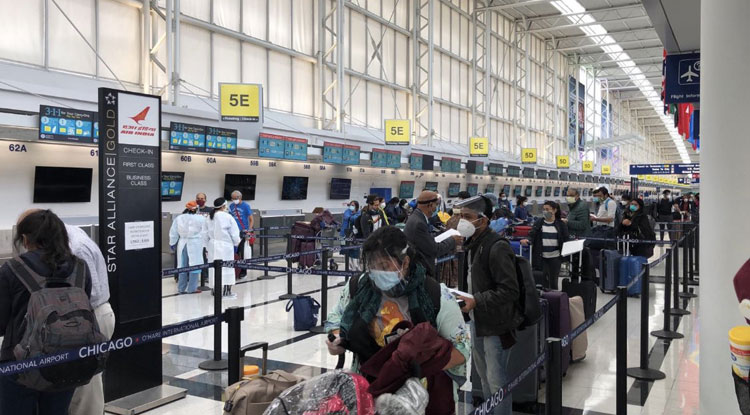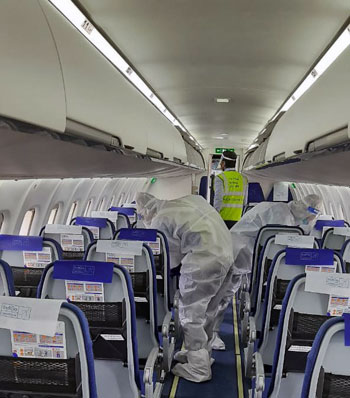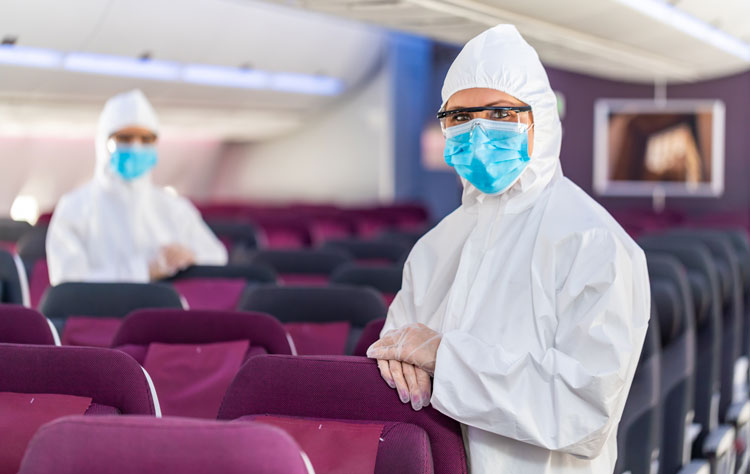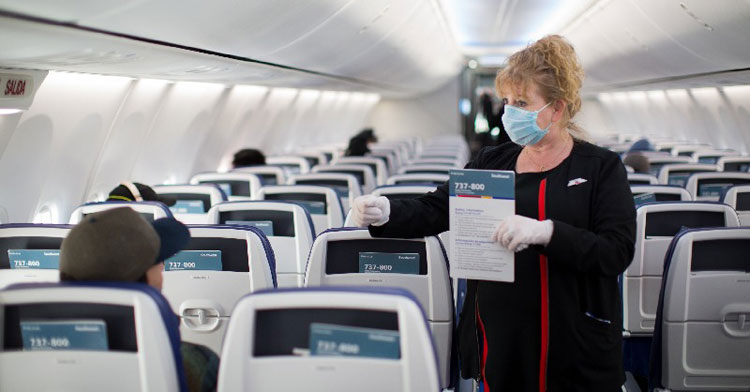INDIAN ARMED FORCES CHIEFS ON
OUR RELENTLESS AND FOCUSED PUBLISHING EFFORTS

SP Guide Publications puts forth a well compiled articulation of issues, pursuits and accomplishments of the Indian Army, over the years

I am confident that SP Guide Publications would continue to inform, inspire and influence.

My compliments to SP Guide Publications for informative and credible reportage on contemporary aerospace issues over the past six decades.
Active implementations & lesser restrictions must for aviation’s faster recovery
To restore the economy recessed due to the novel coronavirus, it is important to get the aviation sector back in action and hence traveller confidence needs to be restored by implementing common guideline around the world, point out global experts.

“COVID-19 has presented the entire world with many new types of challenges, and the need to adjust how we conduct ourselves in our day-to-day lives. As a highly integrated and complex network, international aviation has not been immune to these effects, some of which pose new challenges in managing risks which were never before considered in traditional safety management practices,” Dr. Fang Liu, Secretary General, ICAO (International Civil Aviation Organisation) had commented last month. These last couple of months have brought unprecedented scenarios but with transformational times ahead of us. Aviation industry has been under a spotlight not only because of being largely affected but also for being a large economy bearer globally. It is thereby very important to get this industry in action with necessary changes and precautions.
In line with this, the ICAO Council adopted a new report and recommendations on June 1, 2020 aimed at restarting the international air transport system and aligning its global recovery. This COVID-19 report and guidelines were produced by the Council’s Aviation Recovery Task Force (CART). ICAO underlined that these guidelines were developed through broad-based consultations with countries and regional organisations, and with important advice from the World Health Organisation (WHO) and key aviation industry groups including the International Air Transport Association (IATA), Airports Council International (ACI World), the Civil Air Navigation Services Organisation (CANSO), and the International Coordinating Council of Aerospace Industries Associations (ICCAIA).
ICAO also highlighted that the impact of the coronavirus disease (COVID-19) pandemic on global air transport is without precedent. Airports have seen a -28.4 percent decline in global passenger traffic volumes for the first quarter of 2020, equivalent to a reduction of 612 million passengers in absolute terms.
“The world needs aviation. Solidarity among all countries and regions and industry sectors will be critical going forward,” underscored Salvatore Sciacchitano, ICAO Council President. He also added that the delivery of this report, with its recommendations and take-off guidelines will now align public and private sector actions and mitigations to get the world flying again, in full accordance with the latest and most prudent medical and traveller health advice available.
Gloria Guevara, CEO & President, World Travel & Tourism Council (WTTC) also mentioned that aviation is the backbone of travel industry. “If an airline goes strong, its impact is on all the related agencies too. The entire ecosystem benefits and it works like a domino effect. We need to guarantee the survival of the industry through appropriate implementations now,” she said.

ICAO also highlighted that the impact of the coronavirus disease (COVID-19) pandemic on global air transport is without precedent. Airports have seen a -28.4 per cent decline in global passenger traffic volumes for the first quarter of 2020, equivalent to a reduction of 612 million passengers in absolute terms. These volumes (domestic and international traffic) are expected to decrease by -50.4 per cent for 2020 as a whole as compared to 2019 figures. ICAO estimates that by the end of 2020, the COVID-19 impact on scheduled international passenger traffic could reach reductions of up to 71 percent of seat capacity and up to 1.5 billion passengers globally. Airlines and airports face a potential loss of revenue of up to USD 314 billion and USD 100 billion respectively, for 2020.
The CART Take-off guidance includes a section on Public Health Risk Mitigation Measures, in addition to four operational modules relating to Airport Guidelines, Aircraft Guidelines, Crew Guidelines and Cargo Guidelines.
IATA also urged governments to quickly implement the ICAO’s global guidelines for restoring air connectivity as this is an authoritative and comprehensive framework of risk-based temporary measures for air transport operations during the COVID-19 crisis.
“The universal implementation of global standards has made aviation safe. A similar approach is critical in this crisis so that we can safely restore air connectivity as borders and economies re-open. The Take-off guidance document was built with the best expertise of government and industry. Airlines strongly support it. Now we are counting on governments to implement the recommendations quickly, because the world wants to travel again and needs airlines to play a key role in the economic recovery. And we must do this with global harmonisation and mutual recognition of efforts to earn the confidence of travellers and air transport workers,” said Alexandre de Juniac, IATA’s Director General and CEO.
Guevara stated that recovery is expected but member states must follow the guidelines released by ICAO and the implementation of these guidelines is very crucial. “A coordinated approach between government and private sector is must and it’s required for governments to remove barriers to help us build the confidence back from the travellers. Those are key components to see the recovery happening sooner,” she added also highlighting that this is the time for governments to invest in infrastructure and tourism projects to get the economy moving again and recover faster.
Stating optimistic but still a weak recovery, Alexandre de Juniac, IATA’s Director General and CEO said, “We see domestic opening up in June and expanding in the third quarter. The continental market be it European, Asia Pacific or North America should be restarting under third quarter from July to September and the inter-continental (America to Asia, from Asia to Europe) from the fourth quarter but at the end of 2020, the level of the traffic should be around 50-60% of the levels of 2019 which is still pretty slow.”
Talking about the travel barriers, Juniac also expressed that now that there are published guidelines of controlled measures and sanitisation, released by ICAO, we do not need quarantine measures separately as that disturbs the travel motives. “ICAO guidelines cover the entire journey. Airports have also been an important part of these guidelines. In conjunction with airports further, we are also working on bringing practical implementation guidelines for the airports and airlines to be used in operational values. A certification and audit process will also be there to have the best and more urbanised implementation all around the world,” he added.
Optimistic for recovery
“Recovery can already be witnessed in domestic markets like that of the US, China, and some countries in Asia. After June 15, we are hoping markets will open in Europe as well and we will see some more of domestic activity followed by regional. For regional, we are seeing some bubbles between Australia and New Zealand, some bubbles in Asia and some others too,” mentioned Guevara on behalf of WTTC.
For regional and domestic markets, WTTC hopes to see some movement in summer time, and is optimistic especially for countries that have done a better job working with the private sector, helping the airlines during this crisis and helping the sector. Then in the fall season hopefully there will be some recovery in the international market as well.

“Government measures will be very important. If there is going to be two weeks of quarantine on arrival, especially when it comes to corporate, there is no way we will see travellers going to those destinations so we will have to work with governments. The barriers will delay the recovery of corporate, even the leisure market and of course corporate is more sensitive, however, we are seeing some good signs coming up from Asia based on the forecast,” said Guevara.
Stating optimistic but still a weak recovery, Juniac said, “We see domestic opening up in June and expanding in the third quarter. The continental market be it European, Asia Pacific or North America should be restarting under third quarter from July to September and the inter-continental (America to Asia, from Asia to Europe) from the fourth quarter but at the end of 2020, the level of the traffic should be around 50-60% of the levels of 2019 which is still pretty slow.”
“It took so many years to recover after 9/11 because the governments didn't work in a coordinated approach. Different safety standards were implemented in every country and every airport. This created uncertainty, fear and that impacted recovery. If you ask me I want to be sure about what to expect, I want to know exactly how will my experience be and building that confidence in the travellers will be very important and crucial,” said Gloria Guevara, CEO & President, World Travel & Tourism Council.
The report released by ICAO mentioned five stages and also highlighted that a risk-based approach will enable transitioning between stages of restarting operations and adjusting the mitigation measures based on risk, while recognising that reverting to previous stages may be necessary. The goal is to maximise consistency and to develop criteria for data reporting and the monitoring processes in support of evaluation and progression to the next stage(s). It is currently not feasible to provide any specificity of timing between these stages. At the time the report was published, most of commercial passenger aviation was in Stage 0 or Stage 1. The stages identified were as follows:
- Stage 0: (A situation with travel restrictions and only minimal movement of passengers between major domestic and international airports.)
- Stage 1: (Initial increase of passenger travel, with relatively low passenger volumes)
- Stage 2: (Passenger volumes will continue to increase, several measures that were required in Stages 0 and 1 may be lifted.)
- Stage 3: (May occur when the virus outbreak has been sufficiently contained in a critical mass of major destinations worldwide as determined by health authorities. There may not be effective pharmaceutical interventions (e.g. therapies or vaccines) commonly available during Stage 3, but contact tracing and testing should be readily available
- Stage 4: (Begins when specific and effective pharmaceutical interventions are readily available in most countries.)
Standardised implementation to restore passenger confidence
Restoring public confidence in air travel has very broad benefits and is a given necessity in the current situation. “This isn’t only about the operational and economic viability of the air transport sector, but of entire societies and regions having their economic livelihoods and stability restored”, Dr. Liu commented.
During an online Masterclass conducted by CAPA (Centre for Aviation), Guevara and Juniac also stressed about global standardisation of measures. They stated how it is crucial for same guidelines to be implemented everywhere in the world to encourage a better travel experience. If same standard measures are being followed everywhere in the world, it allows passengers to be prepared and hence make way for better experience and restored confidence. They also mentioned how travel cannot be completely replaced through video conferences and is sure to bounce back.

“It took so many years to recover after 9/11 because the governments didn't work in a coordinated approach. Different safety standards were implemented in every country and every airport. This created uncertainty, fear and that impacted recovery. If you ask me I want to be sure about what to expect, I want to know exactly how will my experience be and building that confidence in the travellers will be very important and crucial,” said Guevara. It's important to keep the end goal in mind, and the end goal is to restore that confidence and for that we need to endorse and support airports and airlines and ask member states to work with them and create a standard experience. “The standards must be kept the same to build that confidence sooner and individual rules in every country or at different airports must be done away with,” she added.
CART Chairperson Ambassador Philippe Bertoux, the Representative of France to the ICAO Council stated, “These guidelines will facilitate convergence, mutual recognition and harmonisation of aviation COVID-19 related measures across the globe. They are intended to support the restart and recovery of global air travel in a safe, secure and sustainable way. In order to be effective, we need to take a layered and especially a risk-based approach. Measures will be implemented or removed as needed based on the wide ranging medical and other factors which will be at play.”
He further emphasised, “Countries and operators need both autonomy and certainty as they take action to get the world flying again, and the CART guidelines are therefore designed to serve in both these capacities as a common reference, while remaining adaptable. This needs to be understood as a type of ‘living guidance’ which will be continuously updated based on latest risk assessments as we monitor progress and reconnect the world.”
Interactive data models launched by CAPA
CAPA also recently launched a series of interactive data models designed to build and interpret projections of airline capacity in key markets.
Based on the 2019 actuals, the CAPA Airline Capacity Models provide an effective breakdown of each nation’s domestic and international outlook for seat capacity supported by OAG – as well as each city and route pair. Combined with government statements, airline network announcements and capacity projections, it provides a robust and granular guide for future air capacity projection.
Using assumptions around six key phases; Zero/Grounded, Skeleton, Acutely Restricted, Basic, Restrained and Standard, users can track the pace of recovery in their relevant market.
“The impact of COVID-19 has damaged the efficacy of traditional methods of understanding the future size and scale of our industry. Frustrated by the lack of a model that takes into account border closures and other key assumptions around the pace of recovery of domestic and international passenger markets, we set out to build our own model with the support of OAG,” said Derek Sadubin, Managing Director, CAPA.
Airline Capacity Models have now been made available for Australia, New Zealand and China, and models for the UK, France, Germany, the USA, India, Japan, South Korea and other countries are on their way.
Take-off: Guidance for Air Travel through the COVID-19 Public Health Crisis - ICAO
The guidelines divide the public health risk mitigation measures into two sections:
- Generally applicable risk mitigation measures include:
- States and stakeholders must work together to distribute accurate information quickly across the entire passenger travel experience.
- To the extent feasible, people should be able to maintain social distancing consistent with WHO or applicable State health guidelines. Where this distancing is not feasible (for example in aircraft cabins), adequate risk-based measures should be used.
- Face coverings should be worn, consistent with applicable public health guidelines. The type of face covering (non-medical or medical) should be selected while taking into consideration the potential risks and disadvantages of using masks. In all instances, best practices should be followed about when and how to wear, remove, replace, and dispose of them, as well as hand hygiene after removal.
- All areas with potential for human contact and transmission should be cleaned and disinfected as prescribed by public health authorities with frequency based on operational risk assessment.
- States should ensure that health screening is conducted in accordance with the protocols of the relevant health authorities. Screening could include pre-flight and post-flight self-declarations, temperature measurement and visual observation conducted by health professionals.
- Methods for the collection of passenger and employee contact information should be explored, including web applications, to support public health authorities in contact tracing.
- Where feasible and justified, health declaration forms for COVID-19 should be used for all passengers, in line with the recommendations of relevant health authorities.
- At the time of publication, rapid tests cannot be a precondition for travel due to their unreliability or impracticability. It is therefore recommended that States refrain from requiring rapid tests for the time being.
- Risk mitigation measures applicable in below mentioned four modules have been issued, specific to each of them
- Airport: Addresses elements for Airport terminal building, cleaning, disinfecting, and hygiene, physical distancing, staff protection, access, check-in area, security screening, airside areas, gate installations, passenger transfer, disembarking, baggage claim and arrivals areas.
- Aircraft: Addresses boarding processes, seat assignment processes, baggage, interaction on board, environmental control systems, food and beverage service, lavatory access, crew protection, management of sick passengers or crew members, and cleaning and disinfection of the flight deck, cabin, and cargo compartment.
- Crew: To promote safe and sustainable international air travel, a closely coordinated international approach to the treatment of air crews, consistent with recognised public health standards, will be essential to alleviate burdens on critical transportation workers. These currently include screening, quarantine requirements and immigration restrictions that apply to other travellers. There are also specific guidelines addressing the contact of a crew member with a suspected or positive COVID-19 case, reporting for duty, dedicated end-to-end crew layover best practices, crew members experiencing COVID-19 symptoms during layover, and positioning of crew.
- Cargo: Cargo flight crews should apply the same health and safety considerations as passenger flight crews. This module addresses aviation public health including physical distancing, personal sanitation, protective barriers point of transfer to the ramp and the loading and unloading, and other mitigation procedures.





